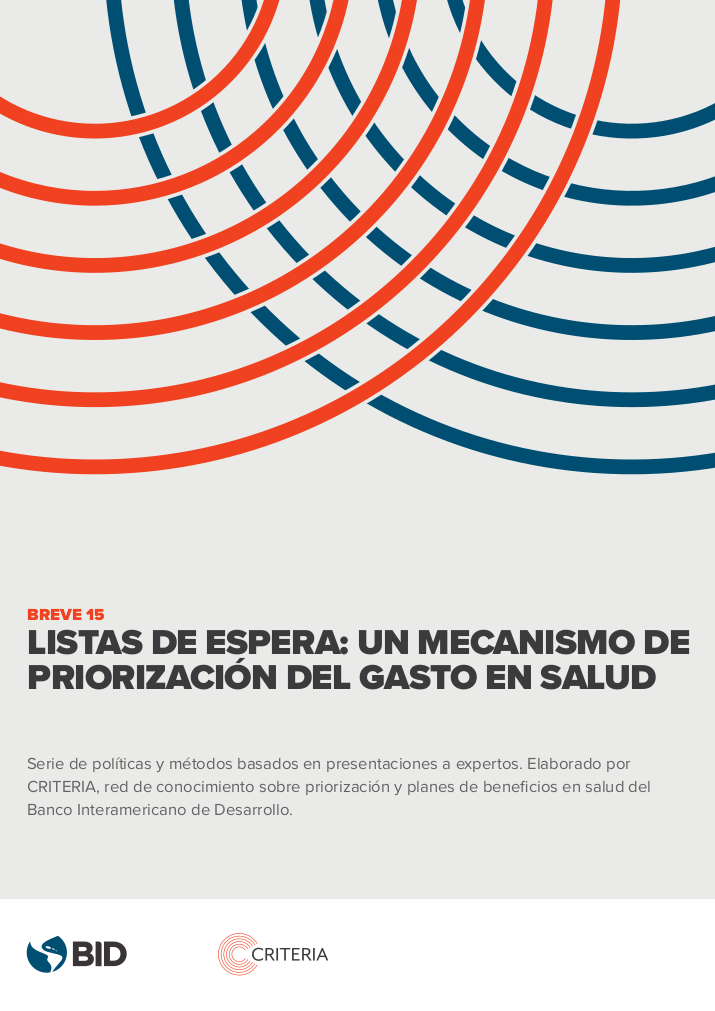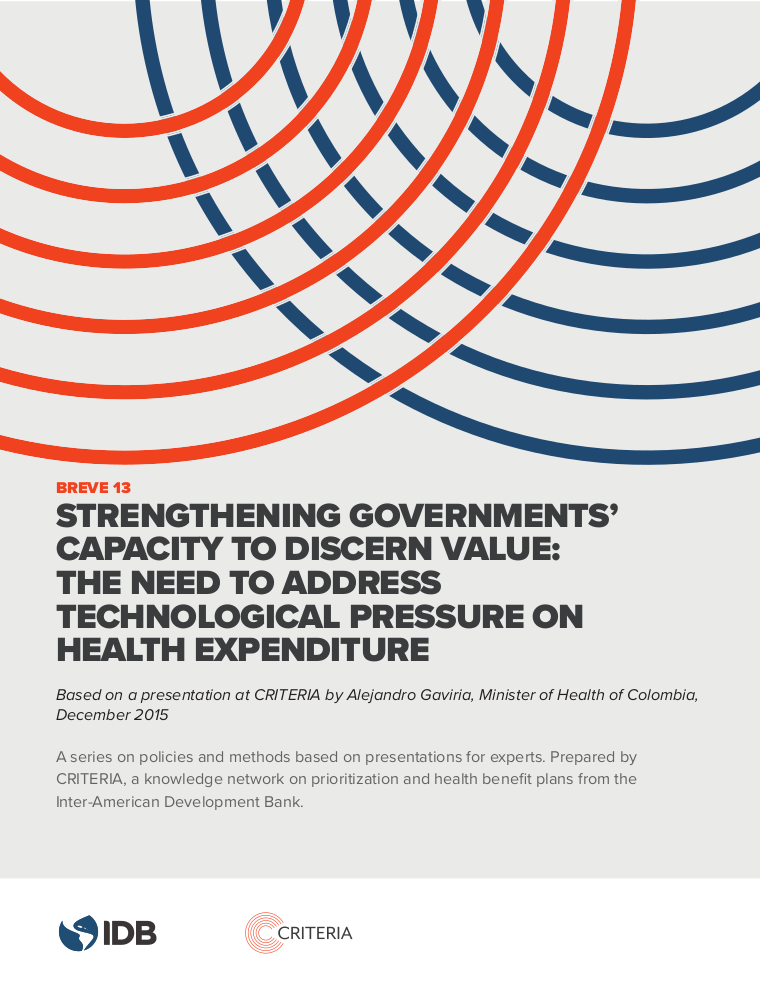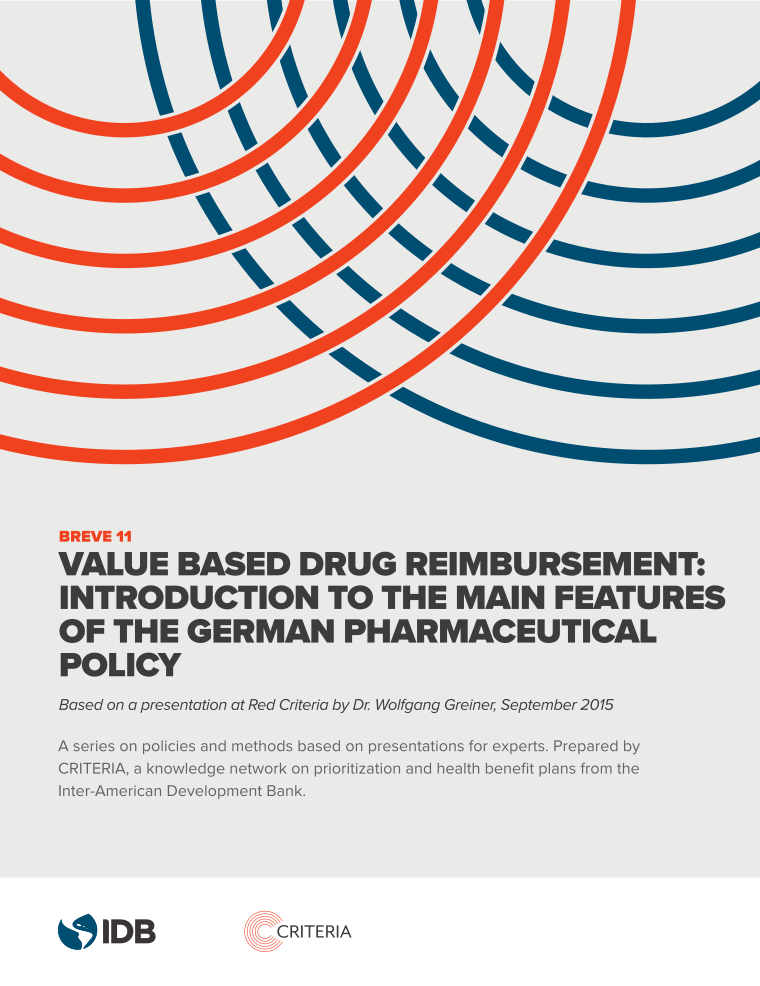Welcome to our library! Here you will find IDB publications on Health Technology Assessment (HTA), Health Benefit Plans (HBP), pharmaceutical policy, drugs and medical devices regulation, catastrophic funds, and horizon scanning, among others. We classify our publications into three categories: books, policy documents, and technical notes.
The collection presented here contains all our English publications. If you would like to access our full collection of publications, please visit the Spanish version of our website by changing the language in the upper right corner of this site.
WAITING LISTS: A MECHANISM FOR PRIORITIZING HEALTH EXPENDITURE. Prepared by CRITERIA. JULY 2016
This Breve is based on the original thesis work and on a webinar presented by Dr. Fábio Ferride-Barros regarding the "Ethics of Health Resources Allocation in the Publicly Financed Health Care System in Brazil." The perspective offered in this Breve complements a previously published issue documenting the use of health technology evaluation in decision-making in Brazil's health sector (IDB, 2015). The Breve introduces the challenges of priority setting in the context of a large and decentralized national universal health care system, which confronts resource scarcity and substantial inequalities.
This Breve gives an overview of the characteristics of the pharmaceutical sector in Mexico and the main factors resulting in the decision to establish the CCPNM. It briefly discusses the legal framework of the Commission. Then, it looks at the CCPNM's objective and operations, before describingthe negotiation process. The results of the CCPNM in economic and organizational terms, as well as other positive impacts, are analyzed in the subsequent section. Finally, the Breve concludes by presenting some of the challenges emerging from the Mexican experience with its price negotiation scheme.
This Breve presents the story of how, in recent years, the Colombian health system has struggled with technological pressure. The impact of technological pressure on the health sector during the last few years could be summarized by either of two phrases: "the cost of success" or "the adverse consequences of technological pressure." This Breve describes how the inadequateincorporation of health innovations into the system can threaten an egalitarian-inspired reform that has brought social progress. The document also discusses the policy tools Colombia has introduced to face this
technological pressure. A commitment to strengthening the government¿s capacity to discern the value of health care innovations lies at the core of these policies.
This Breve is based on a webinar presented by Dr. Wolfgang Greiner, professor at the University of Bielefeld, member of the scientific Advisorygroup of the German Institute for Quality and Efficiency in Health Care (IQWiG)and the EuroQol group. The presentation was delivered on September 29, 2015, to the members of CRITERIA, the Knowledge Network on Health Benefits Packages and Priority Setting in Health at the Inter-American Development Bank.
The following Breve provides an overview of the main challenges that societies, health care systems, and policy makers are currently facing to confront cancer. This brief analyzes the main characteristics of cancer, and shows how these influence the development of new drugs. At the same time, it looks at some of the implications for patients. It also presents some thoughts on the pharmaceutical industry related to cancer treatments. Finally, it summarizes some policy lessons emerging from the analysis, and explains why basic research, better market regulation and a stronger focus on cancer prevention should be the main priorities to fight cancer in the future.
KEY QUESTIONS WHEN DESIGNING A HEALTH TECHNOLOGY EVALUATION BODY: ANSWERS FROM THREE PERSPECTIVES. NOVEMBER 2015
This Breve is based on a webinar presented by Jonathan Dartnell and Aine Heaney, at NPS MedicineWise, on August 18 of 2015, to the members of CRITERIA, the IDB Knowledge Network on Health Benefits Packages and Priority Setting in Health.
THE COLOMBIA BENEFITS PLAN WHAT LESSONS DOES IT LEAVE US? PRESENTATION BY DR. CLAUDIA VACA. APRIL 2015
This Breve is based on a webinar presented by Tommy Wilkinson, Health Economics Advisor at NICE International, on April, 2014, to the members of CRITERIA, the Knowledge Network on Health Benefits Packages and Priority Setting in Health. Two prime examples of explicit priority setting in the healthcare space can be found in the United Kingdom and New Zealand. The UK's National Institute for Health and Care Excellence (NICE) and its achievements are recognized around the world. New Zealand's Pharmaceutical Management Agency (PHARMAC) has a similar remit to NICE, in that it determines funded access to pharmaceuticals and other technologies while operating within a range of different constraints and contexts. For many, PHARMAC also represents one of the world's most successful case studies in medical priority setting and pharmaceutical expenditure control.
The presentation and its resulting BREVE provide a perspective on the objectives, capacities and products of NICE2 and PHARMAC and explore the comparative advantages of each of these agencies. Specifically, it describes and compares the two agencies and the context in which they work; analyzes and compares their priority setting processes; and presents an overview of the types of Health Technology Assessment (HTA) conducted. Given the relative lack of information currently available in the literature about processes employed by PHARMAC, this policy brief will focus on PHARMAC in greater detail. For full information on NICE and PHARMAC, please refer to their websites www.nice.org.uk and www.pharmac.govt.nz, respectively.










